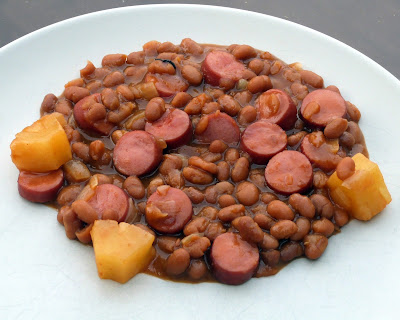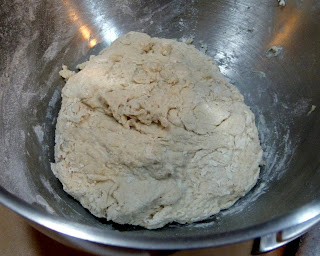I've been working on perfecting my potstickers for years now. I look at my
original post from 2012, and it's almost funny how simplistic it is. Last year's
"Part II" stepped things up considerably, and at the time I thought that was going to be it. In that post, I said "the entire process is now done from scratch." As it turns out, that wasn't completely true. The day has finally arrived where I decided store-bought ground pork is not good enough. That's right, folks, the meat grinder, passed down from Ariel's bubbie, came out to play for the first time today. You might be wondering if it was worth it. Oh, yes. These are the best potstickers I have ever made.

Creating the perfect potsticker filling is the real focus of this post, but I also include all the other steps for completeness. As I've mentioned before, grandpa and grandma have always been vague about what goes into the filling, and I have tinkered with it a lot over the years, incorporating elements of other recipes and my own experimentation. I think I've finally nailed it here. The dried mushrooms contribute their nice earthiness. Using both parts of the napa, and lots of it, lightens the texture and adds a little crunch. The classic combination of ginger and garlic comes through on each bite. And then, of course, there's the meat.

The trouble with prepacked ground pork is that the customer typically gets no information about either the cut it came from or the fat content. Contrast this with beef, where you get the lean/fat ratio and the cut (sirloin, chuck, and so forth). Last time I made dumplings, the pork was too lean and they ended up a little dry. I chose pork shoulder for grinding. Importantly, there is a good amount of fat throughout that keeps the dumplings moist. It's also my preferred cut for
char siu, which was the delicious destiny of the rest of the roast. Shoulder is also excellent for any kind of
stew. Using the rather ancient and venerated grinder was a little intimidating at first, but it ended up working very well. It will no doubt feature in future posts.
This recipe will make at least 150 potstickers, with a little filling left over. It's a good thing they freeze well. I like making potstickers in large batches, as you save time in the long run. You can put frozen potstickers right in the pan and they defrost as they steam for a quick and easy meal. The leftover filling can be cooked like a burger and put on a sandwich. It can be stir fried with a little bean sauce and noodles, or it can go into a frittata. The possibilities are quite endless.
Ingredients
Filling
- 2 lb pork shoulder, with fat
- 2 lb napa, both stalks and leaves
- 1 cup dried black mushrooms, minced (about 12-15 mushrooms)
- 4 cloves garlic, minced
- 2 Tbs fresh ginger, minced
- 2 large eggs
- 1/3 cup green onion, finely chopped
- 1/4 cup fresh chives, finely chopped
- 3 Tbs soy sauce
- 1 Tbs salt
- 1 Tbs sesame oil
- 1 tsp black pepper
- Extra salt for the napa
Wrappers
- 7 cups all-purpose flour
- 2 cups boiling water
- 2/3 cup cold water
Everything Else
- Vegetable oil for frying
- Chinese black vinegar for dipping
- Splash of soy sauce for dipping
Instructions
Filling
Ahead of time, put the mushrooms in a bowl of hot tap water. Let stand at least 30 minutes. Once soaked, remove the stems and finely mince the caps.
Roughly chop the napa, including both the white center parts and the yellowish/greenish leafy parts. In a large bowl, salt the napa and toss to combine. Let stand at least 20 minutes. Working in batches, wrap the napa in a clean towel and wring. Squeeze out as much water as possible. Once this is done, finely chop the napa.
If using ground pork, skip the next step. Otherwise, continue on. Cut the pork into small chunks, making sure to include the fat, and grind. A food processor can be used in place of a grinder. The grinder was quite straightforward to use, and the only challenge was figuring out how to best clamp it down. We ended up opening a drawer to give it room to screw in, and then putting some cardboard on the contact spots to protect the surfaces and stabilize the grinder.
 |
| Meat grinder or time machine? Maybe both. |
Combine mushrooms, napa, and pork in a large bowl. Add all other filling ingredients and mix thoroughly but gently. Cover with plastic wrap and set aside in the refrigerator until ready to fill dumplings.
The filling can be varied to taste. A good way to test the filling is to form a small patty and cook it in a frying pan.
Wrappers
Mix the flour and boiling water, and let stand for 3 minutes. Add cold water and knead into a smooth dough. Roll out on a floured surface, as thin as possible. Using a pint glass or similarly sized glass, cut circles out of the dough. Ball up and scraps and roll out again until all the dough is used.
To avoid dough drying out, it is best to keep the dough in a bag or under plastic wrap. Roll out dough as needed as the dumplings are filled. Usually, we make the dough in two batches -- the amounts given in the ingredients section reflect a double recipe.
Assembly
Prepare the "assembly station" with a large sheet pan and a bowl of water. For each dumpling, take a round wrapper and add a small amount of the filling, around 1/2 Tbs. Take care not to overfill. Over time, you will get the feel for it. It is important to also make sure the filling stays in the center and does not get into the seal. Usually, I form the filling into a slightly elongated shape parallel to the direction of the fold.
Dip a finger in the water and run it around the edge of the wrapper. Fold over and pinch into a moon shape, making sure to seal tightly. Wet the top edge and form 2-3 pleats in the same direction. For detailed photos of wrapping potstickers, see my
original post.
Once the sheet pan is filled, place in the freezer. Once the dumplings are fully frozen, they can be transferred safely to a bag. If the dumplings are bagged too early, they will stick together. The potstickers can also be cooked immediately, but I find they are much easier to detach from the sheet pan once they are at least a little frozen.
Cooking
The key to cooking is the right pan. Nonstick with a well-fitting cover is essential. Add just enough oil to the pan to make a thin layer. On medium high heat, cook the potstickers until the bottoms are lighly browned. Add about a centimeter of water (if the pan is full) and cover. Cook until the water is fully absorbed. Add more oil if needed and fry until the bottoms are crunchy and well-browned.
Serve with Chinese black vinegar, either straight or with a splash of soy sauce.


















































